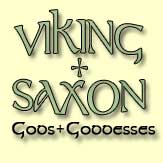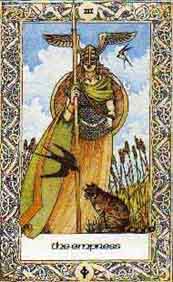
Frigga and Freya developed as different forms of the same goddess. Their attributes and the stories about them are in many cases interchangeable, but to the end of the Viking period subtle distinctions were beginning to develop. However generally they may be considered different aspects of the same deity.
Frigga was the tall, beautiful daughter of Fiorgyni, she was the sister of Jord and, as wife of Odin,was known as the mother of the gods. As the goddess of the sky she wore softly draping garments of purest white, reflecting the colour of the bright clouds. At other times she would be robed in the deeper shades of storms and midnight hues.
When she married Odin there was a great feast of rejoicing, for the Aesir loved her dearly. Indeed it became their custom to celebrate the occasion annually with a festival of jay and happiness. She had strong links with marriage and fertility, and a toast to her health was always proposed at wedding feasts, along with that of Odin and Thor. Sometimes alone, sometimes with Odin, she would sit upon the throne Hlidskialf. and look out aver the world. She had the power to see the future, but would reveal her sacred knowledge to no one.
She lived in the welcoming hall of Fensalir, where the husbands and wives who had been faithful to one another on each would be reunited after death, never to be separated again. It was here too that she would work at her spinning wheel, spinning out long threads of golden cloud. The stars we know as Orion's Belt were called by the Northern peoples Frigga's Spinning-Wheel.
Frigga had several goddesses as attendants of who the best known were Fulla, Hlin and Gna. Fulla, who was according to some her sister, was most often at Frigga's side advising her and sharing her confidence. She was beautiful and wore a fine gold band around her long golden hair which hung loose about her shoulders. Hlin acted as an intermediary between Frigga and her followers, carrying news of their prayers to her mistress. It was also her duty to attend to those in times of trouble or grief, offering them comfort, reassurance and hope. Gna was Frigga's trusted messenger who, mounted upon the horse Hofvarpnir (hoof thrower), would cut swiftly through the air like the refreshing breeze.
Another was Lofn (love), who saw that nothing hindered lovers in their search for happiness. Vjofn had the task of calming quarrels between man and wife, and spreading peace among the people of Midgard.
Guarding the doors of Frigga's hall was Syn (truth), who would obstruct and bar the way against those who were not allowed to enter. Her decision was final - once someone had been turned away nothing could induce her to change her mind. She had therefore an interest in judicial trials and if an idea or suggestion was rejected then it was said that Syn must be against it.
The goddess of medicine and healing was also one of her attendants. Her name was Eira and she would scour the whole earth for powerful ingredients and rare herbs for her remedies. She taught her skills with care to the women of the Northern peoples who, following her fine example, became accomplished healers. Vara punished those who deliberately lied under oath or failed to keep their word. The goddess of virtue was Snotra, who had achieved knowledge of a great many things. Vor (faith) had full vision of the future, seeing clearly all that was about to happen upon the world of men.
© copyright Clive Barrett 2012
www.greenmangatekeeper.com
|



